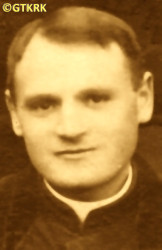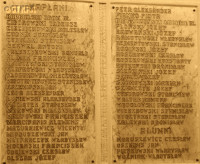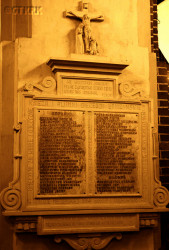Roman Catholic
St Sigismund parish
05-507 Słomczyn
85 Wiślana Str.
Konstancin deanery
Warsaw archdiocese, Poland
full list:
displayClick to display full list

searchClick to search full list by categories
wyświetlKliknij by wyświetlić pełną listę po polsku

szukajKliknij by przeszukać listę wg kategorii po polsku

Martyrology of the clergy — Poland
XX century (1914 – 1989)
personal data
surname
WYSZYŃSKI
forename(s)
Stanislav (pl. Stanisław)
function
diocesan priest
creed
Latin (Roman Catholic) Church RCmore on
en.wikipedia.org
[access: 2014.09.21]
diocese / province
Łomża diocesemore on
www.kuria.lomza.pl
[access: 2012.11.23]
RC Military Ordinariate of Polandmore on
en.wikipedia.org
[access: 2014.12.20]
honorary titles
Silver „Cross of Merit with Swords”more on
Silver „Cross of Merit with Swords”
(c. 1944, posthumously, awarded by the commander of the Białystok District of the Home Army_AK)
„Cross of Valour”more on
„Cross of Valour”
(c. 1944, prob., posthumously, awarded by the commander of the Białystok District of the Home Army_AK)
date and place
of death
23.10.1944

Kosówka foresttoday: Rajgród gm., Grajewo pov., Podlaskie voiv., Poland
more on
en.wikipedia.org
[access: 2022.01.28]
details of death
After German and Russian invasion of Poland in 09.1939 and start of the World War II, after start of Russian occupation — Grajewo was captured by the Germans on 07.09.1939 but on 28.09.1939 was handed over to the Russians in accordance with Ribbentrop–Molotov accords — clandestinely educated, together with his vicar, Fr Alexander Pęza, children and youth.
Organised resistance (the genocidal NKVD started investigation of both clerics under „Bell” name, accusing them of „encouraging young people to join insurgent units and conduct armed struggle against the occupant”).
In 08.1940 accused by the Russians of avoiding taxes.
C. 1,500 parishioners attended the trial demanding release of the accused.
And so it happened.
After German attack on 22.06.1941 of their erstwhile ally, Russians, and start of German occupation, collaborated with Polish resistance Home Army AK (part of Polish Clandestine State) under nom‐de‐guerre „Paul”. Was a chaplain of AK units in the Grajewo district. Led a clandestine cell that was involved in hiding deserters from the German army. Was also a chaplain of the 9th Mounted Rifle Regiment, when attempt to recreate it started in 1943.
Arrested by the Germans on 02.10.1944, as a result of a German provocation — provocateurs appeared at his place, claiming to be deserters from Hungarian units — accused of hiding deserters from the German army.
Sentenced to death and murdered — at the time of the execution was barefoot, without a cassock, with hands bound by a telephone wire.
cause of death
mass murder
perpetrators
Germans
sites and events
Kosówka forestClick to display the description, Help to the JewsClick to display the description, Ribbentrop‐MolotovClick to display the description, Pius XI's encyclicalsClick to display the description
date and place
of birth
29.10.1908

Nowe Wareletoday: Szepietowo gm., Wysokie Mazowieckie pov., Podlaskie voiv., Poland
more on
en.wikipedia.org
[access: 2022.01.28]
presbyter (holy orders)
ordination
15.05.1935

Łomżatoday: Łomża city pov., Podlaskie voiv., Poland
more on
en.wikipedia.org
[access: 2022.01.28]
positions held
1939 – 1944
administrator — Grajewotoday: Grajewo urban gm., Grajewo pov., Podlaskie voiv., Poland
more on
en.wikipedia.org
[access: 2022.01.28] ⋄ Holy Trinity RC parish ⋄ Grajewotoday: Grajewo urban gm., Grajewo pov., Podlaskie voiv., Poland
more on
en.wikipedia.org
[access: 2022.01.28] RC deanery
1939
vicar — Rajgródtoday: Rajgród gm., Grajewo pov., Podlaskie voiv., Poland
more on
en.wikipedia.org
[access: 2021.08.06] ⋄ Nativity of the Blessed Virgin Mary RC parish ⋄ Szczuczyntoday: Szczuczyn gm., Grajewo pov., Podlaskie voiv., Poland
more on
en.wikipedia.org
[access: 2021.08.06] RC deanery
1938 – 1939
vicar — Kuczyntoday: Klukowo gm., Wysokie Mazowieckie pov., Masovia voiv., Poland
more on
en.wikipedia.org
[access: 2022.08.05] ⋄ Our Lord's Resurrection RC parish ⋄ Wysokie Mazowieckietoday: Wysokie Mazowieckie urban gm., Wysokie Mazowieckie pov., Podlaskie voiv., Poland
more on
en.wikipedia.org
[access: 2021.06.07] RC deanery
1937 – 1938
vicar — Kulesze Kościelnetoday: Kulesze Kościelne gm., Wysokie Mazowieckie pov., Podlaskie voiv., Poland
more on
en.wikipedia.org
[access: 2021.12.18] ⋄ St Bartholomew the Apostle RC parish ⋄ Sokołytoday: Sokoły gm., Wysokie Mazowieckie pov., Podlaskie voiv., Poland
more on
en.wikipedia.org
[access: 2021.08.06] RC deanery
1937
vicar — Czyżewtoday: Czyżew gm., Wysokie Mazowieckie pov., Podlaskie voiv., Poland
more on
en.wikipedia.org
[access: 2021.12.18] ⋄ St Peter and St Paul the Apostles RC parish ⋄ Czyżewtoday: Czyżew gm., Wysokie Mazowieckie pov., Podlaskie voiv., Poland
more on
en.wikipedia.org
[access: 2021.12.18] RC deanery
1935 – c. 1936
vicar — Śniadowotoday: Śniadowo gm., Łomża pov., Podlaskie voiv., Poland
more on
en.wikipedia.org
[access: 2021.08.06] ⋄ Assumption of the Blessed Virgin Mary RC parish ⋄ Śniadowotoday: Śniadowo gm., Łomża pov., Podlaskie voiv., Poland
more on
en.wikipedia.org
[access: 2021.08.06] RC deanery
1930 – 1935
student — Łomżatoday: Łomża city pov., Podlaskie voiv., Poland
more on
en.wikipedia.org
[access: 2022.01.28] ⋄ philosophy and theology, Theological Seminary
others related
in death
PĘZAClick to display biography Alexander
sites and events
descriptions
Kosówka forest: In the forest n. Prostki and Bogusze, c. 5 km from Grajewo — not far from a series of POW camps set up after German attack on 21.06.1941 of their erstwhile ally, Russians (Stalag I E, Stalag I F/Z, Stalag I B/PR, Stalag 373 and Oflag 56) — Germans during genocidal extermination of Polish intelligentsia known as „«Black July» 1943” murdered on 15.07.1943 in a mass execution approx. 150 Poles. Among them were member of Polish resistance movement (part of Polish Clandestine State). The „Kosówka” forest was also a place of mass murders of aforementioned POWs. Also later a number of mass murders took place there, among others on 20.01.1945 when c. 120 Poles were executed there. (more on: historialomzy.plClick to attempt to display webpage
[access: 2013.08.17])
Help to the Jews: During World War II on the Polish occupied territories Germans forbid to give any support to the Jews under penalty of death. Hundreds of Polish priests and religious helped the Jews despite this official sanction. Many of them were caught and murdered.
Ribbentrop‐Molotov: Genocidal Russian‐German alliance pact between Russian leader Joseph Stalin and German leader Adolf Hitler signed on 23.08.1939 in Moscow by respective foreign ministers, Mr. Vyacheslav Molotov for Russia and Joachim von Ribbentrop for Germany. The pact sanctioned and was the direct cause of joint Russian and German invasion of Poland and the outbreak of the World War II in 09.1939. In a political sense, the pact was an attempt to restore the status quo ante before 1914, with one exception, namely the „commercial” exchange of the so‐called „Kingdom of Poland”, which in 1914 was part of the Russian Empire, fore Eastern Galicia (today's western Ukraine), in 1914 belonging to the Austro‐Hungarian Empire. Galicia, including Lviv, was to be taken over by the Russians, the „Kingdom of Poland” — under the name of the General Governorate — Germany. The resultant „war was one of the greatest calamities and dramas of humanity in history, for two atheistic and anti‐Christian ideologies — national and international socialism — rejected God and His fifth Decalogue commandment: Thou shall not kill!” (Abp Stanislav Gądecki, 01.09.2019). The decisions taken — backed up by the betrayal of the formal allies of Poland, France and Germany, which on 12.09.1939, at a joint conference in Abbeville, decided not to provide aid to attacked Poland and not to take military action against Germany (a clear breach of treaty obligations with Poland) — were on 28.09.1939 slightly altered and made more precise when a treaty on „German‐Russian boundaries and friendship” was agreed by the same murderous signatories. One of its findings was establishment of spheres of influence in Central and Eastern Europe and in consequence IV partition of Poland. In one of its secret annexes agreed, that: „the Signatories will not tolerate on its respective territories any Polish propaganda that affects the territory of the other Side. On their respective territories they will suppress all such propaganda and inform each other of the measures taken to accomplish it”. The agreements resulted in a series of meeting between two genocidal organization representing both sides — German Gestapo and Russian NKVD when coordination of efforts to exterminate Polish intelligentsia and Polish leading classes (in Germany called «Intelligenzaktion», in Russia took the form of Katyń massacres) where discussed. Resulted in deaths of hundreds of thousands of Polish intelligentsia, including thousands of priests presented here, and tens of millions of ordinary people,. The results of this Russian‐German pact lasted till 1989 and are still in evidence even today. (more on: en.wikipedia.orgClick to attempt to display webpage
[access: 2015.09.30])
Pius XI's encyclicals: Facing the creation of two totalitarian systems in Europe, which seemed to compete with each other, though there were more similarities than contradictions between them, Pope Pius XI issued in 03.1937 (within 5 days) two encyclicals. In the „Mit brennender Sorge” (Eng. „With Burning Concern”) published on 14.03.1938, condemned the national socialism prevailing in Germany. The Pope wrote: „Whoever, following the old Germanic‐pre‐Christian beliefs, puts various impersonal fate in the place of a personal God, denies the wisdom of God and Providence […], whoever exalts earthly values: race or nation, or state, or state system, representatives of state power or other fundamental values of human society, […] and makes them the highest standard of all values, including religious ones, and idolizes them, this one […] is far from true faith in God and from a worldview corresponding to such faith”. On 19.03.1937, published „Divini Redemptoris” (Eng. „Divine Redeemer”), in which criticized Russian communism, dialectical materialism and the class struggle theory. The Pope wrote: „Communism deprives man of freedom, and therefore the spiritual basis of all life norms. It deprives the human person of all his dignity and any moral support with which he could resist the onslaught of blind passions […] This is the new gospel that Bolshevik and godless communism preaches as a message of salvation and redemption of humanity”… Pius XI demanded that the established human law be subjected to the natural law of God , recommended the implementation of the ideal of a Christian state and society, and called on Catholics to resist. Two years later, National Socialist Germany and Communist Russia came together and started World War II. (more on: www.vatican.vaClick to attempt to display webpage
[access: 2023.05.28], www.vatican.vaClick to attempt to display webpage
[access: 2023.05.28])
sources
personal:
www.grajewiak.plClick to attempt to display webpage
[access: 2013.12.04], lomzynskie24.plClick to attempt to display webpage
[access: 2013.12.04], historialomzy.plClick to attempt to display webpage
[access: 2013.08.17]
original images:
grajewiak.plClick to attempt to display webpage
[access: 2020.09.27]
LETTER to CUSTODIAN/ADMINISTRATOR
If you have an Email client on your communicator/computer — such as Mozilla Thunderbird, Windows Mail or Microsoft Outlook, described at WikipediaPatrz:
en.wikipedia.org, among others — try the link below, please:
LETTER to CUSTODIAN/ADMINISTRATORClick and try to call your own Email client
If however you do not run such a client or the above link is not active please send an email to the Custodian/Administrator using your account — in your customary email/correspondence engine — at the following address:

giving the following as the subject:
MARTYROLOGY: WYSZYŃSKI Stanislav
To return to the biography press below:
 Click to return to biography
Click to return to biography











